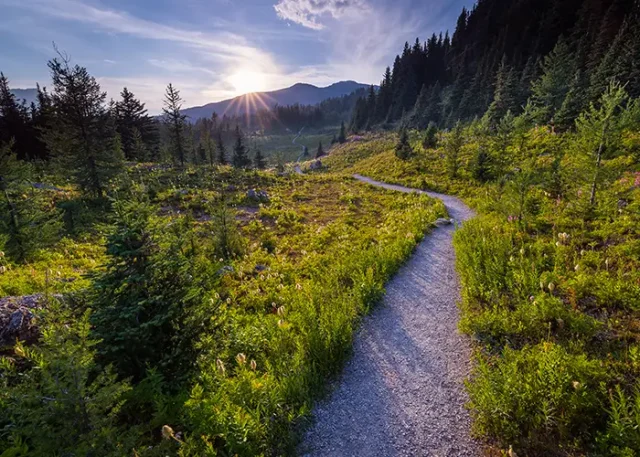
Stepping onto a trail usually slows a traveler down in ways cities can’t. Once the noise fades, attention shifts to smaller details again. A ridge line that looks close turns out to be a slow climb, and a river forces a pause because the water makes rushing impossible.
Many travelers chase trails around the world, sometimes planned, sometimes stumbled into. What stays with them are the places where the path feels naturally settled into the landscape. The routes below stand out for that reason. Each one offers its own pace, and each leaves something small but lasting after the walk ends.
Patagonia’s Trails
In Patagonia, the trails tend to test how much a person actually wants to walk. The wind behaves on its own terms, and hikers adjust as they go. Near El Chaltén, many realise the sky appears unusually large, almost stretched out. The path moves through brush, opens suddenly, and reveals Fitz Roy in a way that feels earned rather than staged.
Gravel crunches underfoot while a low whistle rolls off the peaks. Some travellers stay quiet because the scenery keeps shifting, and they’re trying to take it in. Others end up talking with strangers about whether the weather will hold.
The trails aren’t confusing, but they keep hikers honest. People walk slower than planned, noticing details they would’ve missed elsewhere. Patagonia encourages that kind of pace, almost nudging them along while they settle into the rhythm of wide, open country.
Botswana’s Quiet Wild
Botswana’s wilderness feels quiet, though the quiet isn’t empty. Birds announce themselves before they’re visible, and sometimes a distant herd shifts the ground in subtle ways. Travelling toward the Okavango Delta often means following paths marked more by wildlife than people.
Visitors arrive expecting to experience luxury holidays in Botswana; even just walking through this landscape is a luxury in itself. Light bounces across shallow channels, and hidden roots keep hikers watching the ground. Warm air never sits still. A whiff of damp earth might drift in from a place still out of view.
Distances stretch farther than expected, and a lone tree keeps retreating as a person walks toward it. This part of Botswana encourages attention without demanding it. The trail draws people into its pace, and the landscape ultimately shapes how they move, whether they planned it or not.
Trailing the Japanese Alps
The Japanese Alps offer trails that feel tucked away even when towns aren’t far off. Starting early from Kamikōchi usually means stepping into cool air that wakes a traveller up quickly. The path traces a river that shifts from clear to a soft blue where it runs deeper. Wooden bridges look delicate but hold steady underfoot. Voices from hikers echo before they appear around bends in the valley.
The climb toward Dakesawa Lodge rises gradually, noticeable mostly in tired legs. Simple lunches taste better after being carried all morning. Clouds move fast here, turning the light on the ridges from bright to muted without warning. The area doesn’t feel remote so much as calm, hinting that visitors should match its steady pace. Many do. The trail keeps pulling them forward with quiet nudges.
New Zealand’s Steady Paths
On New Zealand’s South Island, trails seem woven into the land rather than built over it. After a stretch of rain on the Routeburn Track, the soil stays soft and holds onto moisture. Water sounds come from every direction, from thin streams threading over stones to deeper falls humming behind thickets of beech.
The forest light turns gentle, and the air smells faintly of moss. As hikers climb toward Harris Saddle, the wind picks up and leans into them. Quick greetings pass between travellers who soon disappear behind curves hiding whatever comes next.
Stopping usually feels colder than moving, so most keep going. At the lake near the top, the stillness makes people lower their voices without thinking about it. Clouds drift across the ridges in slow lines. Many stay longer than planned, just watching the sky reshape itself.
Planning Walks Close to Home
Some trails don’t demand grand scenery or long journeys. They just need enough room for someone to drift along at a pace that feels honest. When people talk about walking more, the idea of shaping their own route usually comes up. It makes sense, because trying to plan your self guided walking holidays gives you control over how the day unfolds; choose when to start, where to wander, and when to stop without checking a schedule.
In England, for example, paths slip through farmland and fold over old stone walls in a steady, unhurried way. Walkers move through gates, step around soft patches of mud, and wait while sheep decide whether to stand aside. Sometimes they chat with someone tending a field; other times they just keep going under low branches. The weather turns quickly, so a jacket stays close. Nothing feels arranged, and that freedom shapes the walk more than anything else.
What Stays With You After the Walk?
Certain trails linger long after the mud washes off boots because they meet travellers where they are. Some arrive tired, others curious, and some just want a break from screens. The trail doesn’t demand more. It offers room to walk, look around, and let the mind drift.
Sometimes the memory becomes a ridge line; other times it’s a short exchange with a stranger or the quiet of a packed lunch eaten too early. Whatever sticks tends to return at odd moments, usually when needed. A good trail does that. It keeps echoing in a small, steady way long after the walk ends.





